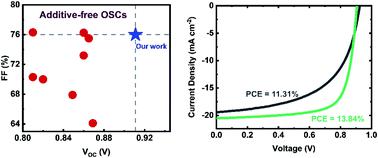当前位置:
X-MOL 学术
›
J. Mater. Chem. A
›
论文详情
Our official English website, www.x-mol.net, welcomes your feedback! (Note: you will need to create a separate account there.)
Crystallization driven boost in fill factor and stability in additive-free organic solar cells
Journal of Materials Chemistry A ( IF 11.9 ) Pub Date : 2021-10-11 , DOI: 10.1039/d1ta08232a David Garcia Romero 1 , Lorenzo Di Mario 1 , Giuseppe Portale 1 , Maria Antonietta Loi 1
Journal of Materials Chemistry A ( IF 11.9 ) Pub Date : 2021-10-11 , DOI: 10.1039/d1ta08232a David Garcia Romero 1 , Lorenzo Di Mario 1 , Giuseppe Portale 1 , Maria Antonietta Loi 1
Affiliation

|
The control of morphology and microstructure during and after the active layer processing of bulk-heterojunction solar cells is critical to obtain elevated fill factors and overall good device performance. With the recent development of non-fullerene acceptors, wide attention has been paid to improve miscibility, solubility and nanoscale separation by laborious molecular design processes and by the use of additives. Nonetheless, several post-processing strategies can equally contribute to obtain an optimum phase separation and even to an enhanced crystallinity, but their effect on performance and device lifetime of polymer/non-fullerene acceptor solar cells is still unclear. Herein, we report a systematic comparison between different post-processing treatments including thermal annealing (TA), vacuum drying (VD) and solvent vapor annealing (SVA) on the TPD-3F polymer and IT-4F non-fullerene acceptor, comparing their effects on device performance as well as on the morphology and optical and electrical properties. The optimized SVA treated devices exhibited power conversion efficiencies close to 14% with a remarkable 76% fill factor and superior short-circuit currents compared to the one of untreated devices. Moreover, SVA demonstrated improvements in device stability both under illumination and under ambient conditions. The induced phase separation and the increased crystallinity of the acceptor molecules, as revealed by GIWAXS measurements, led to increased photogenerated currents, with a more effective exciton dissociation and charge collection. The open-circuit voltage losses in the SVA and TA devices were explained by a bandgap reduction and a higher trap-assisted recombination, respectively. Overall, our study points to the role of post-processing in organic solar cell fabrication, and contributes towards a new generation of efficient and stable additive-free organic solar cells.
中文翻译:

结晶驱动的无添加剂有机太阳能电池填充因子和稳定性的提高
在体异质结太阳能电池的活性层处理期间和之后,形态和微观结构的控制对于获得更高的填充因子和整体良好的器件性能至关重要。随着最近非富勒烯受体的发展,人们广泛关注通过繁琐的分子设计过程和添加剂的使用来改善混溶性、溶解性和纳米级分离。尽管如此,几种后处理策略同样有助于获得最佳相分离,甚至提高结晶度,但它们对聚合物/非富勒烯受体太阳能电池的性能和器件寿命的影响仍不清楚。在此,我们报告了包括热退火 (TA) 在内的不同后处理处理之间的系统比较,TPD-3F 聚合物和 IT-4F 非富勒烯受体的真空干燥 (VD) 和溶剂蒸汽退火 (SVA),比较它们对器件性能以及形态和光学和电学性能的影响。与未经处理的器件相比,经过优化的 SVA 处理器件的功率转换效率接近 14%,具有显着的 76% 填充因子和出色的短路电流。此外,SVA 在光照和环境条件下都展示了器件稳定性的改进。GIWAXS 测量显示,诱导相分离和受体分子结晶度增加导致光生电流增加,激子解离和电荷收集更有效。SVA 和 TA 器件中的开路电压损失分别通过带隙减小和更高的陷阱辅助复合来解释。总的来说,我们的研究指出了后处理在有机太阳能电池制造中的作用,并有助于新一代高效稳定的无添加剂有机太阳能电池。
更新日期:2021-10-26
中文翻译:

结晶驱动的无添加剂有机太阳能电池填充因子和稳定性的提高
在体异质结太阳能电池的活性层处理期间和之后,形态和微观结构的控制对于获得更高的填充因子和整体良好的器件性能至关重要。随着最近非富勒烯受体的发展,人们广泛关注通过繁琐的分子设计过程和添加剂的使用来改善混溶性、溶解性和纳米级分离。尽管如此,几种后处理策略同样有助于获得最佳相分离,甚至提高结晶度,但它们对聚合物/非富勒烯受体太阳能电池的性能和器件寿命的影响仍不清楚。在此,我们报告了包括热退火 (TA) 在内的不同后处理处理之间的系统比较,TPD-3F 聚合物和 IT-4F 非富勒烯受体的真空干燥 (VD) 和溶剂蒸汽退火 (SVA),比较它们对器件性能以及形态和光学和电学性能的影响。与未经处理的器件相比,经过优化的 SVA 处理器件的功率转换效率接近 14%,具有显着的 76% 填充因子和出色的短路电流。此外,SVA 在光照和环境条件下都展示了器件稳定性的改进。GIWAXS 测量显示,诱导相分离和受体分子结晶度增加导致光生电流增加,激子解离和电荷收集更有效。SVA 和 TA 器件中的开路电压损失分别通过带隙减小和更高的陷阱辅助复合来解释。总的来说,我们的研究指出了后处理在有机太阳能电池制造中的作用,并有助于新一代高效稳定的无添加剂有机太阳能电池。



























 京公网安备 11010802027423号
京公网安备 11010802027423号